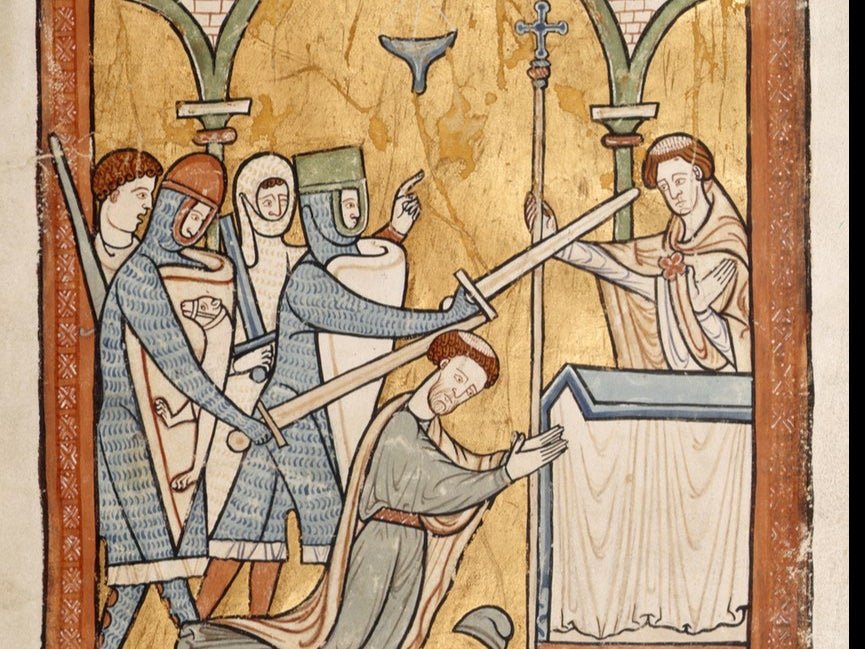Revealed: How mass tourism helped England after the Black Death
Finds from “England’s Venice” reveal the secrets of medieval pilgrimage
New historical research is revealing how medieval mass tourism helped revive key aspects of England’s economy after the Black Death.
At least a third of the population died as bubonic plague devastated the country - especially towns - in the mid-14th century.
Key parts of the nation’s financial system went into decline - but, in an unexpected way, fear of the plague helped revive many of England’s urban economies.
New research at the University of York’s Centre for Pilgrimage Studies, is now beginning to reveal the surprisingly efficient ways in which England’s plague-battered towns went about reviving their economic fortunes - through a medieval form of mass tourism.
Fear of the plague made people more religious and more susceptible to religious marketing aimed at persuading them to embark on pilgrimages to saintly shrines in towns and cities throughout England.
The new investigations into the management and economics of the medieval pilgrimage industry has revealed that each major pilgrimage centre (often cathedrals) would seek to market their ‘pilgrimage offer’ only around four times a year - so as to deliberately concentrate mass tourism in their specific town into a manageable series of very short seasons.
This maximised efficiency and profit, while minimising mass tourism’s impact on normal ecclesiastical life.
The new research, carried out by Dr John Jenkins, co-director of the Centre for Pilgrimage Studies, also shows that even the highly profitable sale of pilgrimage memorabilia(especially pilgrims’ badges) was organised in a much more efficient way than previously thought.
Instead of badges being produced separately in each individual pilgrimage centre, many were produced en masse by specialist badge makers who would travel from pilgrimage centre to pilgrimage centre throughout the year.

It’s estimated that there were at least 10 million English people who went on pilgrimage between 1300 and 1450 - with each person going on several pilgrimages, often at least half a dozen in their lifetime.
They would have collected badges (made of pewter) from many or even most of the pilgrimage shrines they visited - so throughout the late medieval period, literally tens of millions of badges must have been produced.
Over recent decades, it’s estimated that more than 10,000 have been found by metal detectorists - but only around a thousand have found their way to museums (ie., a miniscule percentage of the numbers originally produced).
Only a few museums have really good collections - but one of them, Salisbury, will tomorrow (Saturday) open a special new gallery, featuring many of the hundred badges so far found in that city.
The new exhibition will reveal the extraordinary range of places that the people of medieval Salisbury went on pilgrimage to - pilgrimage centres like Canterbury, Walsingham, Chester, St. Albans, Bury St Edmunds, Westminster, Ely and Windsor.
Abroad, the badges reveal that Salisbury citizens visited the shrine St John the Baptist in Amiens Cathedral, France; St Peters Basilica in Rome; the Shrine of the Holy Blood at Wilsnack in Germany; and the shrine of St James in Santiago de Compostela in Spain.

Although pilgrimages were religious undertakings, they also often reflected stark political divisions within medieval society.
Some pilgrimages (to places like Pontefract, York and Windsor) were often perceived by the authorities as anti-government subversion because the unofficial ‘saints’ that the pilgrims were venerating there had often been anti-government rebels or ‘unfairly’ deposed rulers, prior to their usually violent deaths.
Typical examples of such unofficial rebel political ‘saints’ included a 14th century baron (who had ruled England for four years but was ultimately beheaded); a deposed English Lancastrian king, almost certainly murdered in prison by his ruthless Yorkist successor; and an archbishop who co-led a rebellion, was sentenced to death by a kangaroo court but insisted on being beheaded with five blows - to imitate Christ’s five crucifixion wounds.
Although popular fear of the Black Death boosted the concept and practise of pilgrimage, government fear of pilgrimages spreading subversive ideas led to draconian attempts to suppress them.
Indeed, as early as 1388, the government issued a law, stating that nobody could travel outside their locality without a letter of authority! Throughout the later Middle Ages, some pilgrimages therefore became controversial political statements and ‘freedom of movement’ issues.

Salisbury internationally important collection of pilgrim badges will be displayed in Salisbury Museum in a brand new gallery telling the story of the city from the 13th century to the present day. It’s the centrepiece of a £5.1 million museum redevelopment, mainly funded by the National Lottery Heritage Fund.
“The new gallery will help the public understand the growth of an important medieval town - and how its citizens travelled far and wide to venerate saints throughout England and abroad” said Dr Jenkins.
“Medieval people were far more mobile, both domestically and internationally, than many people might imagine,” he explained. “Salisbury’s collection of pilgrim badges is one of the finest in the world and is of international significance,” said Dr Jenkins Salisbury used to be called ‘the English Venice’ - because of its network of substantial drainage channels.
But, by the 19th century, those channels were so unhygienic that they were contributing to cholera outbreaks. The English Venice’s urban waterways were therefore removed and replaced by more modern sewers and water supply systems.
It was during those 19th century civic works that a huge number of medieval finds came to light, including a large variety of pilgrim badges, revealing just how widely travelled the medieval citizens of Salisbury were - and suggesting how internationally mobile many medieval English people were.
Join our commenting forum
Join thought-provoking conversations, follow other Independent readers and see their replies
Comments
Bookmark popover
Removed from bookmarks